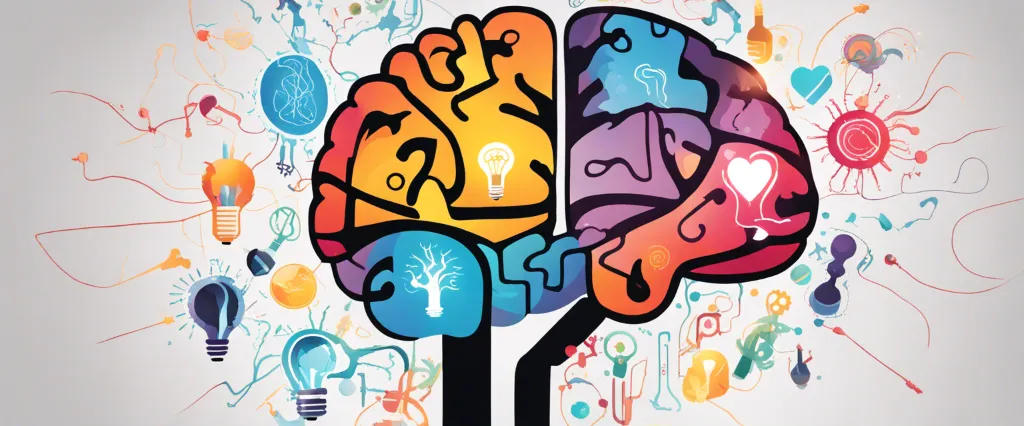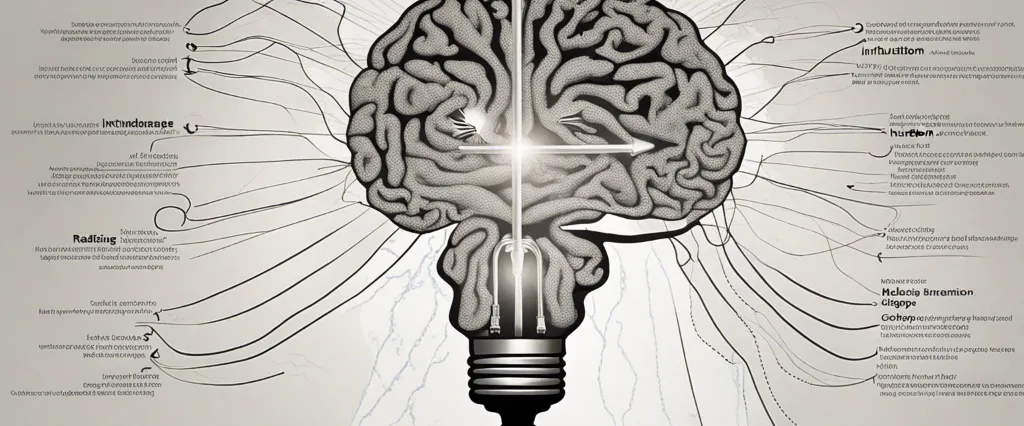In “Super Brain,” renowned author Deepak Chopra delves into the fascinating world of neuroscience and offers groundbreaking insights on how to tap into the limitless potential of our minds. In collaboration with the renowned medical professor Rudolph E. Tanzi, Chopra explores the immense power of the human brain and its capacity for growth, adaptability, and transformation. This profound guide challenges conventional beliefs about aging and decline, providing practical tools and strategies to enhance cognitive abilities and cultivate a healthier, sharper, and more resilient brain. Deepak Chopra, a pioneer in integrative medicine and a prolific author, is widely known for his vast contributions to the fields of spirituality, holistic health, and consciousness. His expertise in bridging Eastern philosophies with Western science has earned him international recognition. With his profound understanding of the mind-body connection, Chopra offers a unique perspective on unlocking the astonishing potential of the brain in “Super Brain.”
Chapter 1: Unleashing the Potential Beyond the Brain
Chapter 1 of the book “Super Brain” by Deepak Chopra, titled “Unleashing the Potential Beyond the Brain,” introduces the concept of the super brain and explores how the brain has historically been misunderstood. Chopra, along with his co-author Rudy Tanzi, aims to challenge the traditional understanding of the brain as a fixed entity and instead presents a view that the brain is endlessly malleable and capable of great transformation.
The chapter begins by highlighting the limitations of the current scientific approach to studying the brain, which typically focuses on its physical structure and neurological processes. While acknowledging the advancements made in understanding the brain’s functioning, Chopra asserts that this approach neglects the brain’s immense potential beyond its physicality.
He then delves into the idea of the “super brain,” which transcends the limits of conventional thinking and embraces the possibility of expanding consciousness and reaching higher states of awareness. Chopra and Tanzi argue that the brain is not confined to the boundaries of the skull, but is also influenced by the entire body and its environment. They emphasize that the brain is constantly evolving and adapting in response to experiences, thoughts, emotions, and lifestyle choices.
The authors introduce the concept of neuroplasticity, which describes the brain’s ability to reorganize and form new neural connections throughout life. This highlights the brain’s inherent capacity for growth and transformation, providing hope for individuals struggling with cognitive decline or neurological disorders.
In this chapter, Chopra and Tanzi set the stage for the rest of the book, inviting readers to look beyond the traditional limitations of the brain and explore the immense potential that lies within. They encourage readers to tap into their own super brain by adopting a holistic approach that takes into account the mind, body, and environment, and by actively engaging in practices that support brain health and growth.
Chapter 2: The Brain and Mind-Body Health
Chapter 2 of “Super Brain” by Deepak Chopra delves into the relationship between the brain and mind-body health. The chapter begins by emphasizing that the brain and body are interconnected, with thoughts and emotions having a significant impact on physical health. The mind-body connection is a concept that has been recognized by various ancient healing traditions but is now being supported by scientific research.
Chopra highlights the brain’s plasticity, which is its ability to change and adapt throughout life. This plasticity allows individuals to develop new neural pathways, leading to improved cognitive abilities and emotional well-being. The author emphasizes that by engaging in activities such as meditation, exercise, and social interaction, individuals can positively influence the brain’s neuroplasticity, leading to enhanced mind-body health.
The chapter also explores the effects of stress and chronic inflammation on the brain. Chronic stress, which can be caused by various factors such as work pressure and personal relationships, negatively impacts brain health. It is revealed that stress can lead to the degeneration of brain cells and the shrinkage of certain brain regions. Additionally, chronic inflammation in the body contributes to brain diseases such as Alzheimer’s and depression.
To counteract these detrimental effects, Chopra suggests various strategies for maintaining and enhancing mind-body health. These strategies include stress management techniques like meditation and deep breathing exercises, adopting a healthy diet, engaging in regular physical exercise, cultivating positive emotions, and fostering social connections. By implementing these practices, individuals can improve their brain health, promote overall well-being, and reduce the risk of cognitive decline and mind-body imbalances.
In conclusion, Chapter 2 of “Super Brain” emphasizes the interconnectedness of the brain and mind-body health. It emphasizes the brain’s plasticity, the negative impacts of stress and chronic inflammation, and provides strategies for improving mind-body health through meditation, exercise, diet, positive emotions, and social connections.
Chapter 3: The Power of Spirituality and Consciousness
Chapter 3: The Power of Spirituality and Consciousness in the book “Super Brain” by Deepak Chopra explores the profound impact of spirituality and consciousness on our brain’s functioning and overall well-being. The chapter begins by emphasizing that the brain is not limited to mere material existence but is also connected to a higher, spiritual reality.
Chopra introduces the concept of the “observer effect,” demonstrating that our thoughts, emotions, and intentions can influence our brain’s activity and the world around us. He highlights that our consciousness has the ability to shape our experiences and reality. By tapping into deep levels of awareness through practices such as meditation and mindfulness, we can access higher states of consciousness and optimize our brain’s functioning.
The chapter delves into the idea of synchronicity, a phenomenon wherein events occur with meaningful coincidences that cannot be explained by cause and effect alone. Chopra suggests that these synchronicities are a result of our heightened awareness and alignment with a higher spiritual order. He emphasizes the importance of engaging with the present moment and attuning our consciousness to the interconnectedness of all things.
Furthermore, Chopra explores the concept of neuroplasticity, which suggests that our brain is capable of rewiring itself based on our thoughts, beliefs, and experiences. He encourages us to engage in practices that foster positive thoughts, emotions, and beliefs, as they have the power to shape our brain’s structure and functionality.
In summary, Chapter 3 of “Super Brain” highlights the transformative power of spirituality and consciousness on our brain’s health and overall well-being. By cultivating mindfulness, embracing present-moment awareness, and nurturing positive thoughts and beliefs, we can enhance our brain’s potential, experience profound synchronicities, and connect with a higher spiritual reality.
Chapter 4: Shaping and Reshaping the Brain

Chapter 4 of “Super Brain” by Deepak Chopra explores the concept of neuroplasticity and how our brains can continuously shape and reshape themselves throughout our lives. The authors emphasize that the brain is not a fixed organ but rather a dynamic entity that can adapt and change, offering hope for personal growth and development.
The chapter begins by discussing how our everyday experiences, thoughts, and emotions physically sculpt the brain. This process is driven by neuroplasticity, which refers to the brain’s ability to form new connections, reorganize neural networks, and even create brand new brain cells. The authors emphasize that this plasticity is not limited to early childhood development but continues throughout life, allowing us to learn, grow, and heal.
The authors also highlight the idea of cortical remapping, which occurs when the brain reallocates its resources in response to changes in a person’s life. For example, if someone loses a limb, the region of the brain that used to control movement in that limb may be repurposed for other functions, such as increasing sensitivity in the remaining limbs. This remarkable ability of the brain to adapt allows individuals to compensate for injuries or disabilities and maintain a high level of functioning.
Furthermore, the chapter highlights the impact of lifestyle choices on brain plasticity. Adopting habits such as regular physical exercise, a healthy diet, stress reduction, and engaging in mental stimulation can promote the growth of new brain cells and enhance the brain’s ability to adapt. The authors provide scientific evidence supporting the idea that activities like meditation and mindfulness can reshape the brain by promoting mental clarity and emotional well-being.
Overall, Chapter 4 of “Super Brain” underscores the incredible potential of the human brain to change and adapt throughout life. By tapping into neuroplasticity and making conscious lifestyle choices, we can actively shape and reshape our brain, leading to greater mental and physical vitality.
Chapter 5: Balancing the Mind and Emotions
Chapter 5 of “Super Brain” by Deepak Chopra focuses on the concept of balancing the mind and emotions. The chapter explores how our emotional state and mental well-being can greatly affect our overall health and cognitive abilities.
Chopra begins by explaining that emotional balance is essential for peak brain function. Emotions such as stress, anxiety, and anger can disrupt the brain’s ability to think clearly and make rational decisions. On the other hand, positive emotions such as love, joy, and compassion enhance cognitive abilities and promote a healthy brain.
The chapter delves into the importance of managing stress, as chronic stress can damage the brain and impair its functions. Chopra introduces various techniques to reduce stress, including meditation, mindful breathing, and exercise. These practices help calm the mind, balance emotions, and reduce the production of stress hormones that can harm the brain.
Furthermore, the chapter emphasizes the significance of emotional intelligence, which refers to our ability to understand and manage our own emotions and empathize with others. Emotional intelligence promotes self-awareness, effective communication, and better decision-making skills, all of which contribute to a healthier and more balanced brain.
Chopra also highlights the power of gratitude in balancing the mind and emotions. Expressing gratitude shifts our focus from negativity to positivity, which helps cultivate a peaceful and content state of mind. Gratitude exercises, such as keeping a gratitude journal or practicing gratitude meditation, can enhance brain function and improve overall emotional well-being.
In conclusion, chapter 5 of “Super Brain” illustrates the crucial connection between mind, emotions, and brain health. By managing stress, practicing emotional intelligence, and cultivating gratitude, individuals can achieve a balanced mental and emotional state that promotes optimal brain function and supports overall well-being.
Chapter 6: Meditation and the Expansion of Consciousness
Chapter 6 of the book “Super Brain” by Deepak Chopra is titled “Meditation and the Expansion of Consciousness.” In this chapter, Chopra explores the concept of meditation as a tool for expanding consciousness and enhancing brain function.
The chapter begins by discussing the scientific research conducted on the benefits of meditation. Chopra explains how meditation can bring about positive changes in the brain by activating the prefrontal cortex, the part of the brain associated with self-awareness and decision-making. Through meditation, individuals can develop a heightened sense of awareness, enabling them to perceive reality more clearly and make better choices.
Chopra also highlights the role of meditation in quieting the mind and reducing stress. He discusses the connection between stress and brain health, explaining how chronic stress can lead to cognitive decline and other mental health issues. Meditation, on the other hand, has been shown to lower stress levels and promote a state of calmness and relaxation, thereby improving overall brain function.
Furthermore, the chapter explores the concept of expanded consciousness through meditation. Chopra explains that meditation allows individuals to transcend their limited sense of self and connect with a deeper, universal consciousness. This expansion of consciousness opens up new possibilities for personal growth and transformation.
Chopra also introduces the concept of mindfulness, emphasizing the importance of being fully present in the moment and observing one’s thoughts and emotions without judgment. This practice can enhance self-awareness and promote a sense of inner peace.
Overall, Chapter 6 of “Super Brain” highlights the profound impact that meditation can have on the brain, including enhanced self-awareness, reduced stress, and an expanded sense of consciousness. Through regular meditation practice, individuals can develop a heightened state of awareness and tap into their full potential.
Chapter 7: The Brain and Creativity
Chapter 7 of “Super Brain” by Deepak Chopra focuses on the relationship between the brain and creativity. The chapter explores how creative thinking and intelligence can be enhanced by understanding the nature of the brain and harnessing its full potential.
Chopra begins by explaining that creativity is not limited to artistic pursuits, but is an essential aspect of problem-solving and innovation in all areas of life. He argues that creativity is not exclusive to a select group of individuals but is a quality that can be cultivated and developed by everyone.
The chapter highlights the brain’s ability to change and adapt through neuroplasticity. Chopra explains that by engaging in new experiences, challenging the mind, and learning continuously, individuals can stimulate the growth of new neural connections and improve cognitive function.
The author introduces the concept of “neural networks” and discusses how they play a crucial role in the creative process. These networks are formed by the connections between different regions of the brain, and when activated, they allow for the generation of innovative ideas and solutions.
Chopra also emphasizes the importance of relaxation and reducing stress for fostering creativity. He explains that when the brain is under stress, it becomes focused on survival and defense mechanisms, inhibiting free-flowing creative thinking. By practicing mindfulness, meditation, and other stress-reducing techniques, individuals can create an optimal mental environment for creativity to flourish.
Furthermore, the chapter discusses the significance of intuition in the creative process. Intuition, according to Chopra, is a form of intelligence that taps into deeper levels of consciousness. By honing intuition, individuals can tap into their inner wisdom and access novel ideas and solutions.
In summary, Chapter 7 of “Super Brain” explores how the brain and creativity are interconnected. It highlights the brain’s ability to change and adapt through neuroplasticity and emphasizes the importance of engaging in new experiences, reducing stress, and honing intuition in cultivating creative thinking. By understanding and harnessing the brain’s potential, individuals can enhance their ability to think creatively and unlock their full creative potential.

Chapter 8: Self-Realization and Transcendence
Chapter 8 of “Super Brain” by Deepak Chopra is titled “Self-Realization and Transcendence.” In this chapter, Chopra explores the concepts of self-realization and transcendence, and how they contribute to expanding consciousness and achieving a state of super brain.
Chopra begins by explaining that self-realization is the process of realizing one’s true nature and essence, going beyond the limited identification with the physical body and ego. It involves recognizing the interconnectedness of all things and understanding that the self is not separate from the world. Transcendence, on the other hand, refers to surpassing the limitations of the ego and accessing higher states of consciousness.
The author emphasizes that self-realization and transcendence are not abstract concepts, but rather practical tools for personal growth and wellness. By cultivating awareness, mindfulness, and meditation, individuals can expand their consciousness, tap into their unlimited potential, and experience a sense of interconnectedness and unity with others.
Chopra also explores the role of belief systems and conditioning in shaping one’s reality and limiting potential. He encourages readers to question their beliefs and conditioned patterns to free themselves from self-imposed limitations.
Furthermore, the chapter delves into the importance of experiencing awe and wonder in life, as these emotions can lead to spiritual growth and a sense of purpose. By appreciating the beauty and magnificence of the universe, individuals can expand their consciousness and connect with their higher selves.
In summary, Chapter 8 of “Super Brain” explores the concepts of self-realization and transcendence as practical tools for personal growth and expanding consciousness. It emphasizes the importance of awareness, meditation, questioning limiting beliefs, and experiencing awe and wonder. By embracing these practices, individuals can tap into their unlimited potential and achieve a state of super brain.
After Reading
In conclusion, Super Brain by Deepak Chopra is a fascinating exploration of the human brain and its potential for growth and transformation. Through scientific research, personal anecdotes, and practical exercises, the book presents a wealth of information and tools for enhancing our cognitive abilities and overall well-being. It emphasizes the importance of cultivating a positive mindset, engaging in healthy habits, and challenging our beliefs and limitations. By understanding and harnessing the power of our brains, we have the ability to not only heal ourselves but also create a more fulfilling and meaningful life. Super Brain is a thought-provoking and inspiring read that encourages us to tap into our unlimited potential and create a brighter future for ourselves and humanity as a whole.
1. The Brain that Changes Itself: Stories of Personal Triumph from the Frontiers of Brain Science” by Norman Doidge – This book delves into the concept of neuroplasticity, providing compelling stories of individuals who have overcome various brain-related challenges through rewiring their brains. It explores groundbreaking research in the field of brain science and highlights the remarkable adaptability of our brains.
2. “The Tell-Tale Brain: A Neuroscientist’s Quest for What Makes Us Human” by V.S. Ramachandran – In a captivating manner, Ramachandran uncovers the mysteries of human consciousness and explores the connections between the brain and various mental phenomena. Drawing on his extensive research, he presents a wide range of fascinating case studies demonstrating the intricacies of the human brain.
3. “Musicophilia: Tales of Music and the Brain” by Oliver Sacks – Renowned neurologist Oliver Sacks explores how music deeply affects our brain and emotions. Through engaging narratives and case studies, he delves into the curious relationships between music and memory, identity, and neurological disorders, ultimately revealing the extraordinary power of music in shaping our lives.
4. “Incognito: The Secret Lives of the Brain” by David Eagleman – This book sheds light on the hidden workings of the brain, bringing to the surface the complex processes that influence our behavior, decision-making, and perception. Eagleman emphasizes the importance of our unconscious mind and how it impacts our daily lives, challenging our understanding of free will and making us question who truly guides our actions.
5. “The Brain’s Way of Healing: Remarkable Discoveries and Recoveries from the Frontiers of Neuroplasticity” by Norman Doidge – Building upon the principles of neuroplasticity, Doidge presents inspiring stories of people who have experienced remarkable recoveries from a variety of neurological conditions. Through innovative approaches, such as light therapy and sound waves, Doidge showcases the potential for healing and transforming the brain, offering hope for those seeking alternative methods of treatment.




